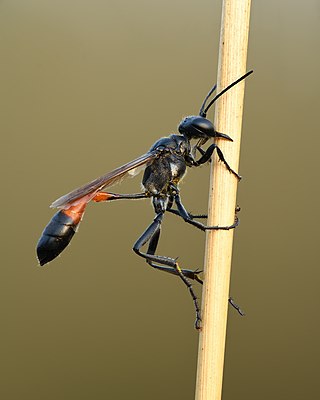
Apidae is the largest family within the superfamily Apoidea, containing at least 5700 species of bees. The family includes some of the most commonly seen bees, including bumblebees and honey bees, but also includes stingless bees, carpenter bees, orchid bees, cuckoo bees, and a number of other less widely known groups. Many are valuable pollinators in natural habitats and for agricultural crops.

The Noctuidae, commonly known as owlet moths, cutworms or armyworms, are a family of moths. They are considered the most controversial family in the superfamily Noctuoidea because many of the clades are constantly changing, along with the other families of the Noctuoidea. It was considered the largest family in Lepidoptera for a long time, but after regrouping Lymantriinae, Catocalinae and Calpinae within the family Erebidae, the latter holds this title now. Currently, Noctuidae is the second largest family in Noctuoidea, with about 1,089 genera and 11,772 species. This classification is still contingent, as more changes continue to appear between Noctuidae and Erebidae.

The bean weevils or seed beetles are a subfamily (Bruchinae) of beetles, now placed in the family Chrysomelidae, though they have historically been treated as a separate family. They are granivores, and typically infest various kinds of seeds or beans, living most of their lives inside a single seed. The subfamily includes about 1,650 species and are found worldwide.

Gentianaceae is a family of flowering plants of 103 genera and about 1600 species.

The Sphecidae are a cosmopolitan family of wasps of the suborder Apocrita that includes sand wasps, mud daubers, and other thread-waisted wasps.

The Crabronidae are a large paraphyletic group of wasps, including nearly all of the species formerly comprising the now-defunct superfamily Sphecoidea. It collectively includes well over 200 genera, containing well over 9000 species. Crabronids were originally a part of the Sphecidae, but the latter name is now restricted to a separate family based on what was once the subfamily Sphecinae. Several of the subfamilies of the Crabronidae are often treated as families in their own right, as is true of the most recent phylogenies.

The Heliantheae are the third-largest tribe in the sunflower family (Asteraceae). With some 190 genera and nearly 2500 recognized species, only the tribes Senecioneae and Astereae are larger. The name is derived from the genus Helianthus, which is Greek for sun flower. Most genera and species are found in North America and South America. A few genera are pantropical.

The Bembicinae comprise a large subfamily of crabronid wasps that includes over 80 genera and over 1800 species which have a worldwide distribution. They excavate nests in the soil, frequently in sandy soils, and store insects of several orders, for example Diptera, Orthoptera, Hemiptera, Lepidoptera and Odonata in the burrows. Some species are kleptoparasites of other Bembicinae. The different subgroups of Bembicinae are each quite distinctive, and rather well-defined, with clear morphological and behavioral differences between them.

The Arctiini are a tribe of tiger moths in the family Erebidae.

The Proteaceae form a family of flowering plants predominantly distributed in the Southern Hemisphere. The family comprises 83 genera with about 1,660 known species. Australia and South Africa have the greatest concentrations of diversity. Together with the Platanaceae, Nelumbonaceae and in the recent APG IV system the Sabiaceae, they make up the order Proteales. Well-known 'Proteaceae genera include Protea, Banksia, Embothrium, Grevillea, Hakea and Macadamia. Species such as the New South Wales waratah, king protea, and various species of Banksia, Grevillea, and Leucadendron are popular cut flowers. The nuts of Macadamia integrifolia are widely grown commercially and consumed, as are those of Gevuina avellana on a smaller scale.

The Elymniini is one of the tribes of the subfamily Satyrinae. If the subfamily Satyrinae elevate to family status, this tribe shall be treated as subfamily Elymniinae. Elymniini was formerly a large group, but recently, it is considered to be include only one genus, Elymnias, according to molecular phylogenetic analyses.

The Lithosiini are a tribe of lichen moths in the family Erebidae. The taxon was described by Gustaf Johan Billberg in 1820.

Astatinae are a cosmopolitan group of solitary wasps, peculiar for their males having very large compound eyes that broadly meet at the top of the head. The largest genus in this subfamily is Astata, with about half of more than 160 species in the subfamily.

Crabronini is a tribe of square-headed wasps in the family Crabronidae. There are 48 genera and over 1,500 described species in Crabronini. Wasps of this tribe are mostly small to very small wasps. Typical of this tribe are the forewings with a single submarginal cell, the lack of membranous metanotal and propodeal modifications, and a square-shaped head.

Proteoideae is one of the five subfamilies of the plant family Proteaceae. The greatest diversity is in Africa, but there are also many species in Australia; a few species occur in South America, New Caledonia, and elsewhere.

Dendrobieae is a tribe in the subfamily Epidendroideae, in the family Orchidaceae. The Dendrobieae are mostly tropical, epiphytic orchids which contain pseudobulbs.

Harpactus is a genus of hunting wasps in the tribe Gorytini.

Trypoxylini is a tribe of traditional Sphecidae in the family Crabronidae. There are at least 840 described species in Trypoxylini.

Gorytina is a subtribe of sand wasps in the family Crabronidae. There are at least 20 genera and 370 described species in Gorytina.

The Sitticini are a tribe of spiders in the family Salticidae. The tribe has been divided into two subtribes, Aillutticina, with five Neotropical genera, and Sitticina, with five genera from Eurasia and the Americas. One genus is unplaced within the tribe. The taxonomy of the tribe has been subject to considerable uncertainty. It was clarified in 2020.




















